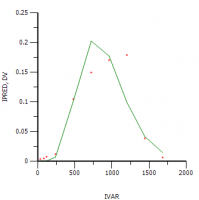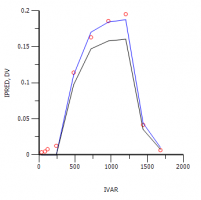Dear Certara Forum users,
I am modeling the PK data of a long-acting formulation. But I can't fit my absorption phase properly. A zero order+tlag absorption model could capture the overall shape, but will ignore the gradual increase at the initial time (when time <=tlag), a transit compartment model could capture the gradual increase at the beginning, but can't capture the shape of the peak. blow are my questions:
1. is that OK I use zero order+transit compartment model? I haven't read a paper with this model yet
2. if so, how can I code it in PML? I have attached my code, which could run successful but the parameter estimates are not plausible
3 meanwhile, IPRED+DV vs time with k0+tlag and ka+transit compartment model was provided as attachments, any other absorption model could I try?
Thanks,
Jing
test(){
transit(Aa, mtt, ntr, max = 50, out = -Aa * Ktr )
dosepoint(Aa)
deriv(A0 = (Aa * Ktr)- K0)
#deriv(Aa = - (Aa * Ktr))
deriv(A1 = K0- (CL * C))
#urinecpt(A0 = (CL * C2))
mtt = (ntr+1)/Ktr
#C = A1 / V
C = A1 / V
K0=Aa/InfDur
error(CEps = 0.00625961)
observe(CObs = C + CEps * sqrt(1 + ©^2 * (CMultStdev/sigma())^2))
stparm(V = tvV * exp(nV))
stparm(Ktr = tvKtr * exp(nKtr))
stparm(ntr = tvntr * exp(nntr))
#stparm(V2 = tvV2 * exp(nV2))
stparm(InfDur = tvInfDur * exp(nInfDur))
stparm(CL = tvCL * exp(nCL))
stparm(CMultStdev = tvCMultStdev)
fixef(tvV = c(0, 40, ))
fixef(tvKtr = c(0, 0.009, ))
fixef(tvntr = c(0, 7, ))
#fixef(tvV2 = c(, 1, ))
fixef(tvInfDur = c(0, 900, ))
fixef(tvCL = c(0, 0.28, ))
fixef(tvCMultStdev = c(, 0.0542587, ))
ranef(diag(nV, nCL, nKtr, nInfDur,nntr) = c(0.1, 0.1, 0.1, 0.1,0.1))
}
















